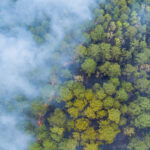ESSIC Post-doctoral Associate Michael Peterson created an animation loop of Hurricane Harvey showing cloud cover and optical lightning emissions on August 25-26, 2017. Peterson combined infrared imagery from GOES-16’s Advanced Baseline Imager (ABI) as well as imagery from the satellite's Geostationary Lightning Mapper (GLM), which observes total lightning (both in-cloud and cloud-to-ground) day and night across the Western Hemisphere. The loop received considerable social media attention via the National Environmental Satellite, Data, and Information Service (NESDIS) dissemination channels.





